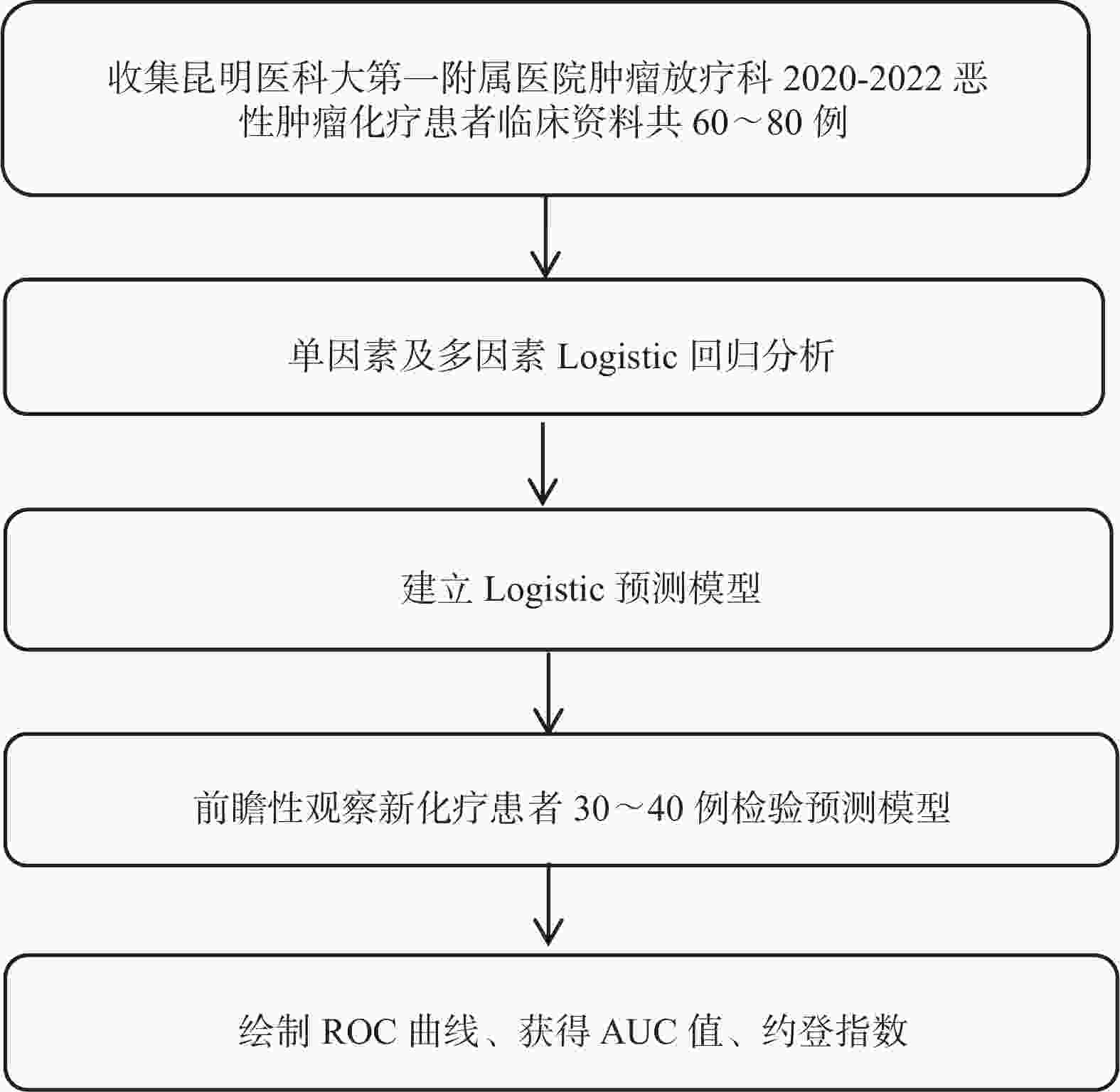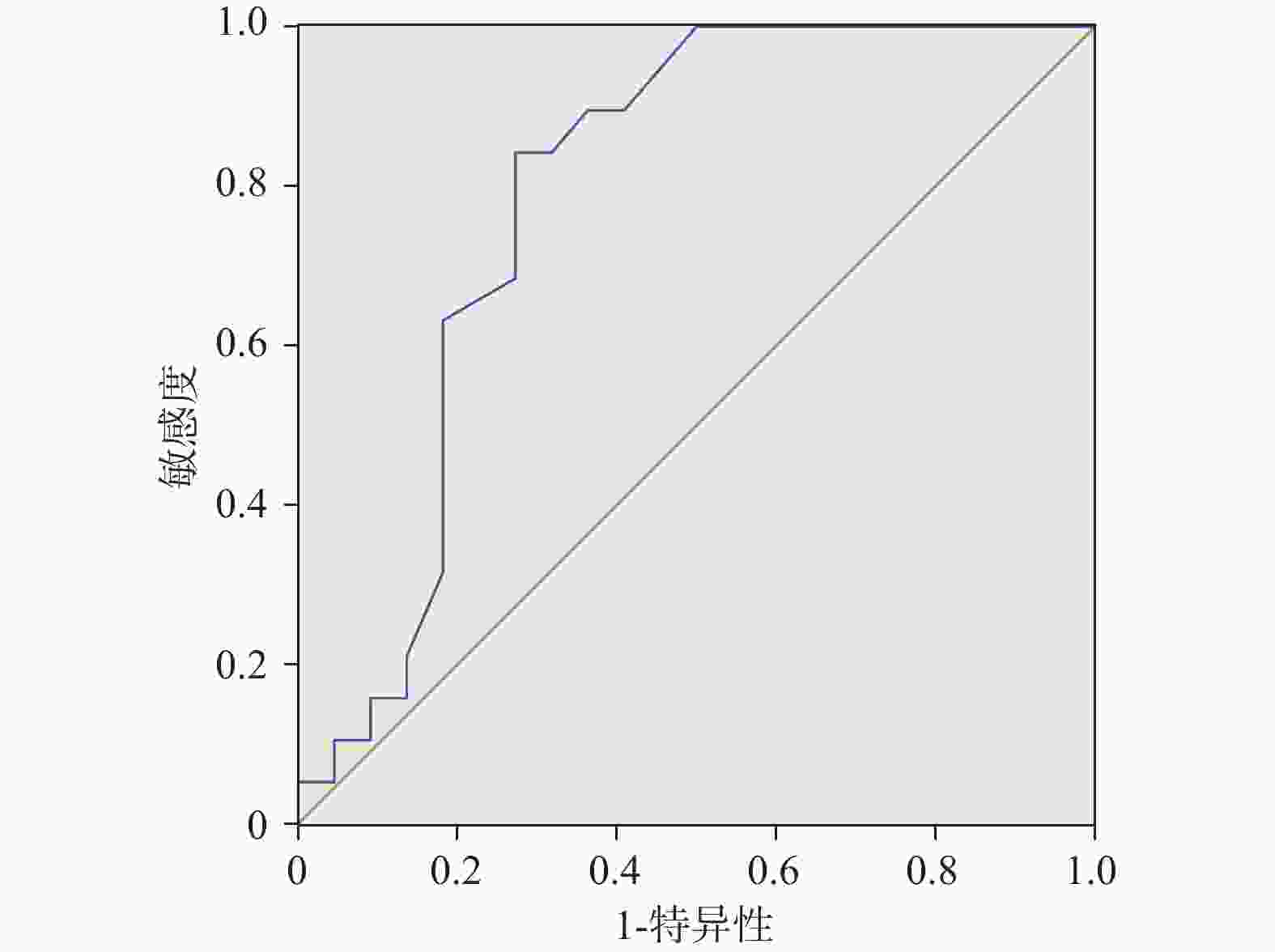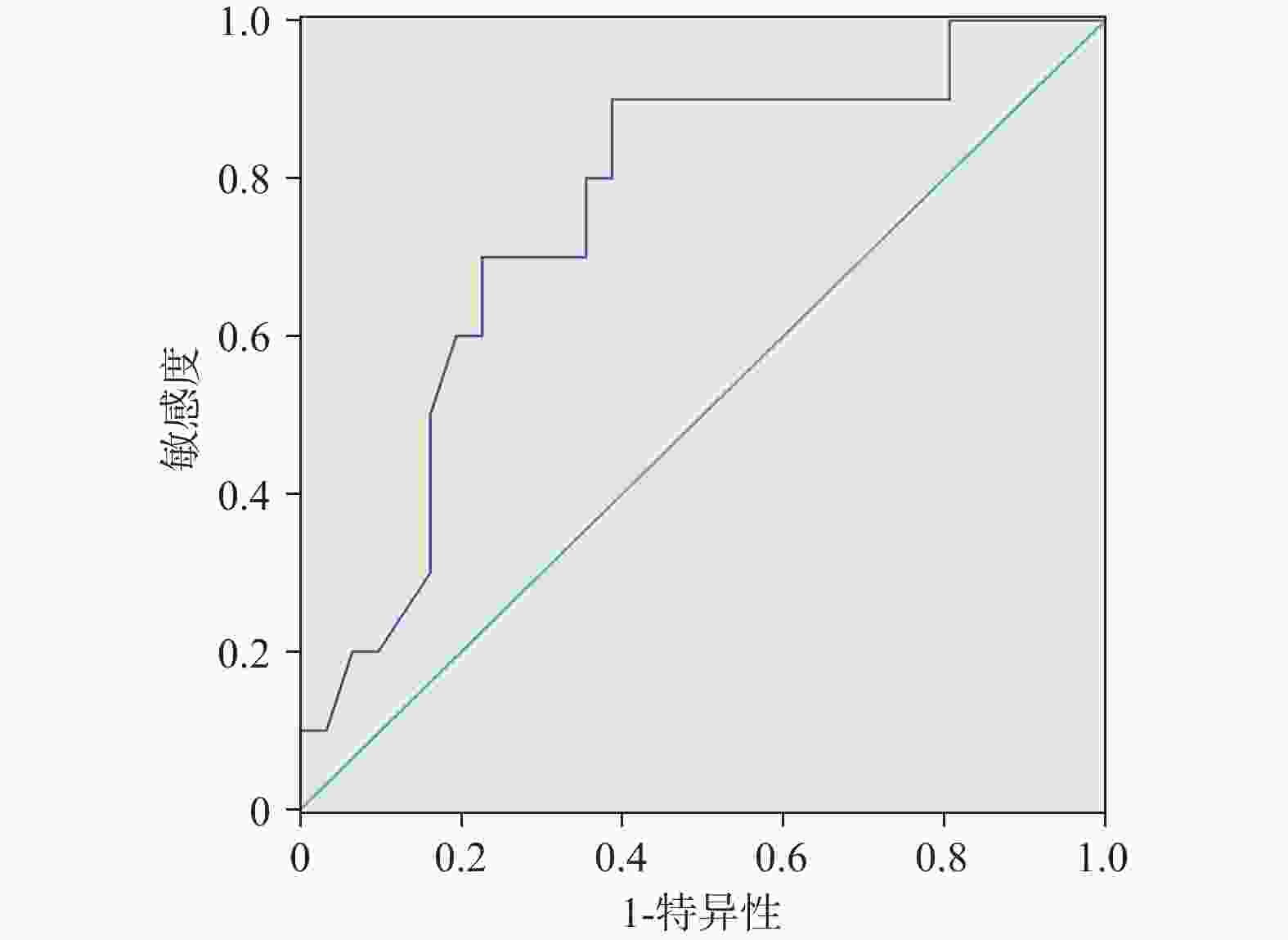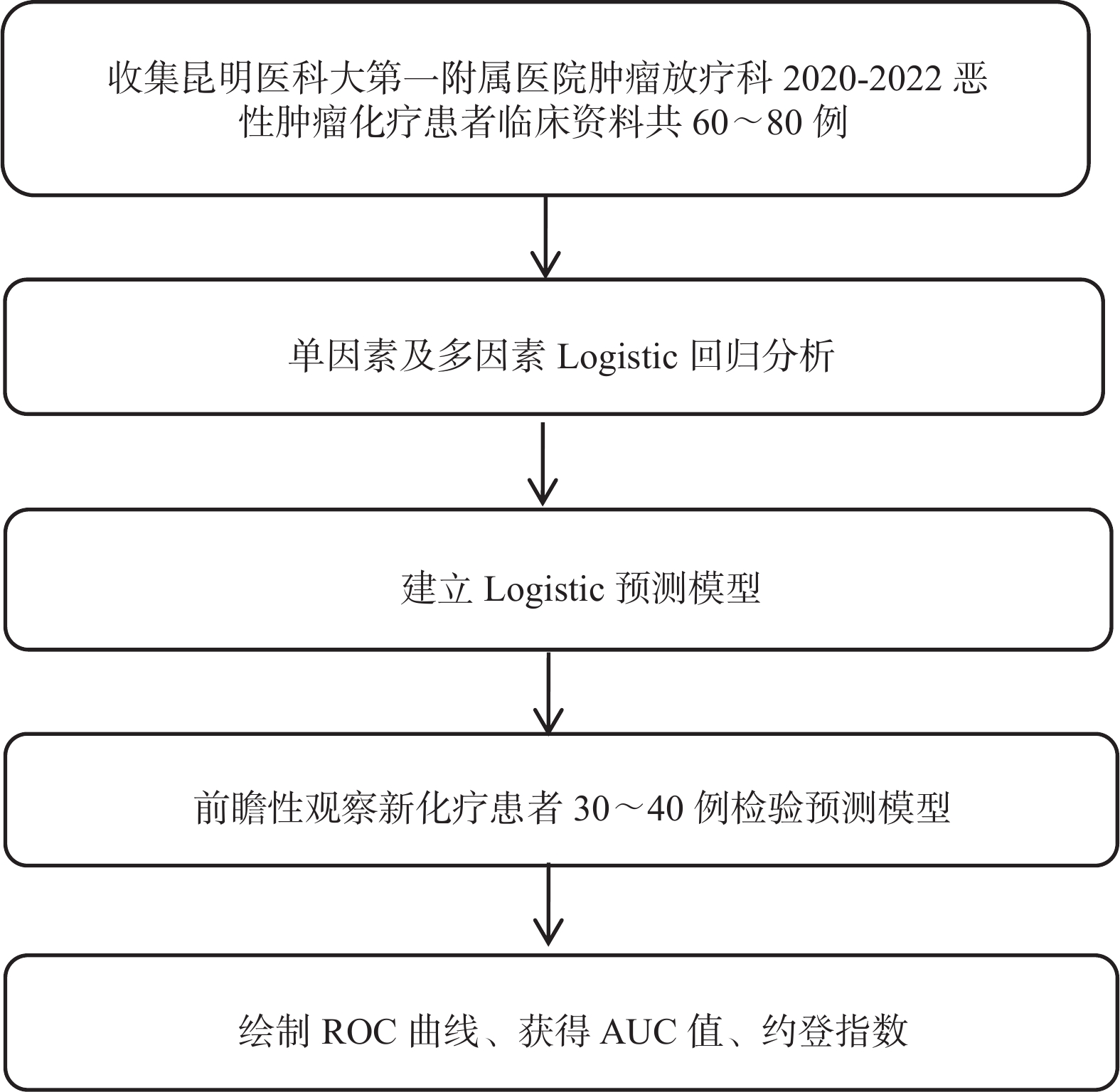Analysis of Risk Factors for Chemotherapy Induced Myelosuppression and Construction of Prediction Models for Myelosuppression Based on Logistic Regression Analysis in Cancer Patients
-
摘要:
目的 研究恶性肿瘤患者化疗后骨髓抑制发生的相关高危因素,并根据高危因素建立Logistic回归预测模型。 方法 匿名收集昆明医科大学第一附属医院2021年1月至2022年12月间化疗患者临床信息80例,将获取的临床资料应用SPSS19.0软件进行Logistic回归单因素分析,明确化疗后骨髓抑制的相关高危因素;将高危因素纳入Logistic多因素回归分析并建立Logistic回归分析预测模型。另外,收集40例左右患者临床信息检验预测模型,获取ROC曲线、AUC值、约登指数等。 结果 经单因素Logistic回归分析,年龄、骨转移、谷丙转氨酶(ALT)、谷草转氨酶(AST)、血清肌酐清除率(CCr)、血清肌酐(Cr)、同期放疗(CRT)、同期免疫治疗(IO)、近期手术等与化疗后骨髓抑制相关(P < 0.05);将高危因素纳入多因素Logistic回归分析,建立相应的预测模型,相应模型的ROC曲线AUC值分别为0.745、0.755及0.791,提示当p值大于上述值时发生相应骨髓抑制的风险较高。相应模型的约登指数分别为0.677、0.713、0.769,提示模型预测效能较好。 结论 恶性肿瘤化疗患者的年龄、血肌酐、血清肌酐清除率、肝功能、近期手术、骨转移、同期放疗/免疫治疗等与化疗后骨髓抑制的发生存在相关性;采用本预测模型进行计算,当p≥0.745(白细胞)、p≥0.755(血小板)、p≥0.791(贫血)时,发生白细胞、血小板、贫血相关骨髓抑制的风险明显增加(≥95%),建议采用相应的预防措施。 -
关键词:
- 化疗 /
- 骨髓抑制 /
- 高危因素 /
- 预测模型 /
- Logistic回归分析
Abstract:Objective To study the risk factors of myelosuppression after the chemotherapy in patients with malignant tumors, and to construct a Logistic regression prediction model based on the risk factors. Methods Clinical information of 80 chemotherapy patients from the First Affiliated Hospital of Kunming Medical University during 2021.01-2022.12 was anonymously collected, and the obtained clinical data were used for Logistic regression univariate analysis with the use of SPSS19.0 software to identify the risk factors related to chemotherapy induced myelosuppression. The risk factors were tested in Logistic multi-factor regression analysis and the Logistic regression analysis prediction models were constructed. In addition, clinical information of 40 patients was collected to test the prediction model, then the ROC curve, AUC value and Youden index were obtained. Results Univariate Logistic regression analysis showed that age, bone metastases, alanine aminotransferase (ALT), aspartate aminotransferase (AST), serum creatinine clearance (CCr), serum creatinine (Cr), concurrent radiotherapy (CRT), concurrent immunotherapy (IO), and the recent surgery were associated with the bone marrow suppression after the chemotherapy (P < 0.05). The AUC values of the ROC curves of the corresponding models were 0.745, 0.755 and 0.791, respectively, indicating that the risk of bone marrow suppression was higher when the predictive model p-value was greater than the above values. The Youden indices of the corresponding models were 0.677, 0.713 and 0.769, respectively, indicating that the prediction performance of the model was better. Conclusion Age, serum creatinine clearance, liver function, the recent surgery, bone metastasis, concurrent radiotherapy/immunotherapy, and serum creatinine clearance are related to the incidence of chemotherapy induced myelosuppression. When p≥0.745 (leukocytes), p≥0.755 (platelets), and p≥0.791 (anemia) through the predictive model calculations, the risk of leukocyte, platelets, and the anemia-related myelosuppression are significantly increased (≥95%), and appropriate preventive measures are recommended. -
Key words:
- Chemotherapy /
- Myelosuppression /
- High risk factors /
- Prediction model /
- Logistic regression analysisy
-
表 1 化疗后白细胞相关骨髓抑制单因素Logistic回归分析
Table 1. Univariate Logistic regression analysis of leukocyte-associated bone marrow suppression after chemotherapy
项目 B S.E. WALS df sig exp(B) 性别 −0.102 0.451 0.051 1 0.822 0.903 年龄 0.097 0.027 13.101 1 0.03 1.102 分期 0.111 0.334 0.111 1 0.739 1.118 骨转移 1.835 0.544 11.359 1 0.001 6.263 吸烟 0.442 0.472 0.875 1 0.35 1.556 谷丙转氨酶 0.024 0.017 1.928 1 0.165 1.025 谷草转氨酶 0.077 0.035 4.827 1 0.028 1.08 血肌酐 0.007 0.009 0.538 1 0.725 1.043 肌酐清除率 −0.082 0.019 17.771 1 0.004 0.922 血尿素氮 0.041 0.079 0.263 1 0.608 1.041 同期放化疗 2.17 0.532 16.631 1 0.01 8.755 同期免疫治疗 4.174 1.064 15.389 1 0.02 65 近期手术治疗 3.145 0.792 15.768 1 0.04 23.222 表 2 化疗后血小板相关骨髓抑制单因素Logistic回归分析
Table 2. Univariate Logistic regression analysis of platelet-related bone marrow suppression after chemotherapy
项目 B S.E. WALS df sig exp(B) 性别 0.085 0.027 10.353 1 0.001 1.089 年龄 −0.056 0.473 0.014 1 0.906 0.946 分期 0.286 0.357 0.643 1 0.423 1.331 骨转移 1.347 0.502 7.203 1 0.007 3.846 吸烟 0.287 0.487 0.347 1 0.556 1.332 谷丙转氨酶 −0.028 0.021 1.778 1 0.182 0.972 谷草转氨酶 −0.007 0.012 0.361 1 0.548 0.993 血肌酐 0.003 0.006 0.238 1 0.625 1.003 肌酐清除率 −0.035 0.016 5.179 1 0.023 0.965 血尿素氮 −0.047 0.096 0.244 1 0.621 0.954 同期放化疗 2.43 0.672 13.065 1 0 11.364 同期免疫治疗 1.459 0.509 8.22 1 0.004 4.301 近期手术治疗 2.988 0.62 23.188 1 0 19.844 表 3 化疗后贫血相关骨髓抑制单因素Logistic回归分析
Table 3. Univariate Logistic regression analysis of anemia-related bone marrow suppression after chemotherapy
项目 B S.E. WALS df sig exp(B) 性别 0.084 0.025 11.298 1 0.001 1.088 年龄 0.486 0.454 1.143 1 0.285 1.625 分期 0.287 0.338 0.72 1 0.396 1.332 骨转移 1.447 0.51 8.062 1 0.005 4.25 吸烟 −0.288 0.472 0.372 1 0.542 0.75 谷丙转氨酶 0.002 0.011 0.046 1 0.831 1.002 谷草转氨酶 0.034 0.025 1.903 1 0.168 1.034 血肌酐 0.038 0.011 10.708 1 0.001 1.038 肌酐清除率 −0.078 0.019 17.123 1 0 0.925 血尿素氮 0.203 0.166 1.493 1 0.222 1.225 同期放化疗 0.773 0.466 2.755 1 0.197 2.167 同期免疫治疗 1.609 0.526 9.362 1 0.002 5 近期手术治疗 2.001 0.576 12.055 1 0.001 7.4 表 4 化疗后白细胞相关骨髓抑制多因素Logistic回归分析
Table 4. Multivariate logistic regression analysis of leukocyte-associated bone marrow suppression after chemotherapy
项目 B S.E. WALS df sig exp(B) 近期手术治疗 1.226 1.233 0.989 1 0.32 3.408 同期放化疗 1.801 0.982 3.359 1 0.047 6.054 同期免疫治疗 3.34 1.246 7.183 1 0.007 28.227 肌酐清除率 −0.046 0.05 0.838 1 0.036 0.955 血肌酐 0.014 0.035 0.17 1 0.681 1.015 谷草转氨酶 0.136 0.081 2.825 1 0.093 1.146 骨转移 0.751 1.042 0.519 1 0.047 2.118 年龄 0.052 0.046 1.263 1 0.021 1.053 常量 −6.356 7.722 0.677 1 0.41 0.002 表 5 化疗后血小板相关骨髓抑制多因素Logistic回归分析
Table 5. Multivariate logistic regression analysis of platelet-related bone marrow suppression after chemotherapy
项目 B S.E. WALS df sig exp(B) 近期手术治疗 2.121 0.745 8.097 1 0.004 8.338 同期免疫治疗 −0.008 0.748 0 1 0.992 0.992 同期放化疗 1.632 0.781 4.369 1 0.037 5.114 肌酐清除率 0.004 0.023 0.034 1 0.044 1.004 骨转移 0.727 0.667 1.191 1 0.275 2.069 年龄 0.032 0.033 0.906 1 0.341 1.032 常量 −4.751 2.772 2.939 1 0.086 0.009 表 6 化疗后贫血相关骨髓抑制多因素Logistic回归分析
Table 6. Multivariate logistic regression analysis of anemia-associated myelosuppression after chemotherapy
项目 B S.E. WALS df sig exp(B) 近期手术治疗 0.542 0.74 0.538 1 0.463 1.72 同期免疫治疗 0.14 0.703 0.039 1 0.843 1.15 肌酐清除率 −0.061 0.03 4.094 1 0.043 0.941 血肌酐 0.004 0.015 0.09 1 0.764 1.004 骨转移 1.251 0.689 3.295 1 0.049 3.495 年龄 0.039 0.028 2.041 1 0.013 1.04 常量 1.214 3.636 0.111 1 0.738 3.367 表 7 预测模型的预测效能
Table 7. Predictive performance of the prediction model
项目 面积 标准误 渐进 Sig 95%CI 约登指数 下限 上限 白细胞 0.745 0.081 0.021 0.587 0.903 0.677 血小板 0.755 0.086 0.016 0.586 0.924 0.713 血红蛋白 0.791 0.074 0.001 0.645 0.936 0.769 -
[1] 白建红. 不同时机营养干预对Ⅳ度骨髓抑制肿瘤患者的影响分析[J]. 临床研究, 2019, 27(4): 19-20. [2] Zhang Q L, Wu T T, Han Y, et al. Chemotherapy-induced myelosuppression in esophageal cancer patients: Risks and suggestions for its management[J]. Curr Med Sci, 2022, 42(3): 530-537. doi: 10.1007/s11596-022-2587-3 [3] Boccia R, Glaspy J, Crawford J, Aapro M. Chemotherapy-induced neutropenia and febrile neutropenia in the US: A beast of burden that needs to be tamed?[J]Oncologist, 2022, 27(1): 625-636. [4] 高艳, 江启安, 李敬国, 等. 实体瘤化疗引起Ⅳ度骨髓抑制的临床分析[J]. 现代肿瘤医学, 2019, 27(1): 111-116 [5] 张龙. 乳腺癌术后化疗诱发重度骨髓抑制相关影响因素探讨[J]. 中外医研究, 2014, 12(26): 42-43. [6] 郭艳霞, 于成宝, 刘秋菊. 化疗后骨髓抑制预测性模型的建立[J]. 吉林医学, 2005, 12(26): 1257-1258. [7] Wang X F, Huang W F, Nie J, et al. Toxicity of chemotherapy regimens in advanced and metastatic pancreatic cancer therapy: A network meta-analysis[J]. J Cell Biochem, 2018, 119(7): 5082-5103. doi: 10.1002/jcb.26266 [8] 朱蓓琳, 骨肿瘤化疗致骨髓抑制的风险因素分析及药学监护模式探索[D]. 上海: 上海交通大学, 2020. [9] Li R, Zhang T, Yan S_H, et al. Chinese medicine combined with adjuvant chemotherapy for improving myelosuppression in colorectal cancer patients: A systematic review and network meta-analysis[J]. Chin J Integr Med, 2024, 30(7): 643-652. doi: 10.1007/s11655-023-3558-7 [10] 中国临床肿瘤学会指南工作委员会. 中国临床肿瘤学会(CSCO)肿瘤化疗相关中性粒细胞减少症规范化管理指南(2021)[J]. 临床肿瘤学杂志, 2021, 26(7): 638-648. doi: 10.3969/j.issn.1009-0460.2021.07.011 [11] Friberg L E, Henningsson A, Maas H, et al. Model of chemotherapy-induced myelosuppression with parameter consistency across drugs[J]. J Clin Oncol, 2002, 20(24): 4713-4721. doi: 10.1200/JCO.2002.02.140 [12] Li M, Wang Q, Lu P, et al. Development of a machine learning-based prediction model for chemotherapy-induced myelosuppression in children with wilms' tumor[J]. Cancers(Basel), 2023, 15(4): 1-19. [13] Dong Y, Hu C, Liu J, et al. Construction of an auxiliary scoring model for myelosuppression in patients with lung cancer chemotherapy based on random forest algorithm[J]. Am J Transl Res, 2023, 15(6): 4155-4163. -






 下载:
下载:





